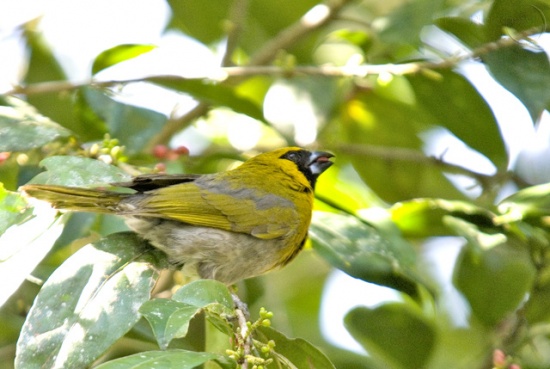- Caryothraustes poliogaster
Identification
16.5 cm
- Black face
- Yellow head, neck and breast
- Olive back, wings and tail
- Grey rump and belly
- Bill, rather heavy and mostly black
Immatures are rather duller. Facial markings more dusky.
Distribution
Central America: found in Mexico, Guatemala, Belize, Honduras, Nicaragua, Costa Rica, Panama
Taxonomy
Some sources include the taxon simulans, which is included in Yellow-green Grosbeak by Clements1 and Ridgely and Gwynne2; simulans which is found in the Darien region of eastern Panama has yellow but no gray on underparts which makes it similar to Yellow-green Grosbeak but not to the other subspecies of Black-faced Grosbeak.
Subspecies[1]
Two subspecies are recognized1:
- C. p. poliogaster:
- C. p. scapularis:
- Caribbean lowlands of Nicaragua to Costa Rica and western Panama
In the past, Black-faced Grosbeak was included in Yellow-green Grosbeak as an additional subspecies.
Habitat
Lowlands and foothills from sea level up to around 1000m.
Found in the canopy and middle levels of dense rain forest in tall second growth, woodland edges and clearings.
Behaviour
Diet
The diet includes beetles, caterpillars, other insects, fruit, seeds and nectar.
Breeding
The nest can be found up to 6m in a small tree. It is usually constructed from bromeliad leaves. The clutch consists of 3 brown-spotted greyish-white eggs which are laid between April and June.
Vocalisation
Calls:sharp chip or tweet, buzzes and whistles; song - whistled cher chi weet, cher chir weet, cher chi chuweet.
References
- Clements, JF. 2009. The Clements Checklist of Birds of the World. 6th ed., with updates to December 2009. Ithaca: Cornell Univ. Press. ISBN 978-0801445019.
- Ridgely and Gwynne
- Avibase
- Wikipedia
Recommended Citation
- BirdForum Opus contributors. (2024) Black-faced Grosbeak. In: BirdForum, the forum for wild birds and birding. Retrieved 26 April 2024 from https://www.birdforum.net/opus/Black-faced_Grosbeak
External Links
GSearch checked for 2020 platform.




